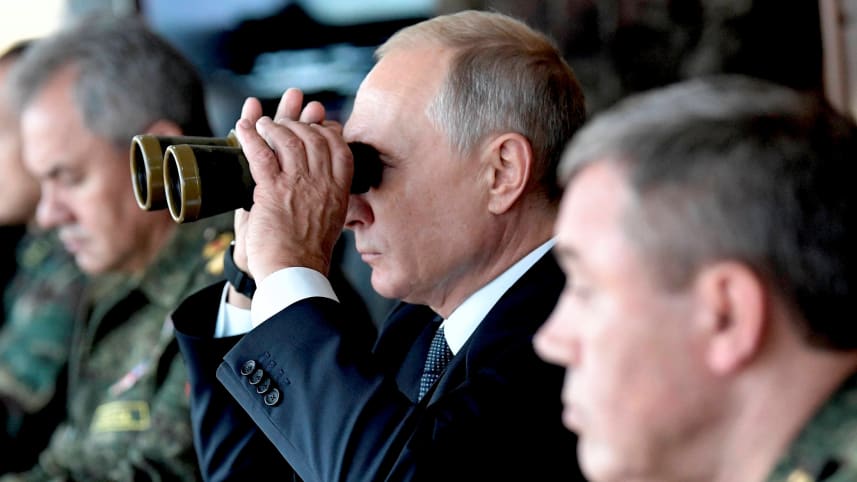Analysis/With S-300 Now in Syria, Putin Signals a New Long-term Strategy for Russia
أنشل بفافر من الهآررتس: مع وجود ال اس 300 في سوريا نيتانياهو يعطي اشارات لإستراتجية طويلة المدى مع روسيا
Anshel Pfeffer/Haaretz/October 04/18
From the Iranian attack on Syria to the U.S. claiming it may take action against new Russian missiles, Putin is flexing his muscles and shows he’s not afraid to challenge any other country.
In an impressive feat of logistics, within two weeks of the incident in which Syria inadvertently shot down a Russian spy-plane, killing all 15 crew members, Russia has now airlifted an entire S-300 air-defense system to its Khmeimim air base in Syria.
It took at least seven flights of the massive Antonov An-124 to airlift the system, taking off from Murmansk, and flying a roundabout route over Iran and Iraq. Russian Defense Minister Sergei Shoigu announced the S-300’s arrival on Tuesday, saying it would be integrated into Russia’s existing air-defense system by October 20 and that Syrian personnel would be trained on its use within three months.
There is a long list of questions for analysts of Russian military affairs that are not fully answered. Are the S-300 batteries that were delivered the most advanced in that series? The differences between versions of radar and missiles could have implications for other air forces flying in the region. How many actual launchers were transported to Syria? Since Russia already operates its own, more advanced S-400 system from Khmeimim, will the new system simply slot into an integrated air-defense network, improving radar coverage and giving more options to track and intercept incoming targets? Or is the ultimate aim to equip the Assad regime with an improved and independent system?
The surprisingly short delivery process raises questions as well. Even large military powers like Russia don’t have these systems just lying around. It’s unthinkable they pulled them out of a frontline operational air-defense battalion, so these batteries either arrived from storage, or they were recently operational and were anyway in the process of being replaced with newer systems. Which leads to the timing.
Russia has spoken in the past of possibly equipping its Syrian allies with S-300s, but this move was announced in the wake of the downing of the Ilyushin Il-20, and interpreted as a move that would make it harder for Israel’s air force to operate over Syria.
Russia blamed Israel for having “provoked” the shooting-down by attacking a joint Iranian-Syrian missile production facility near Latakia. But in recent days, the Russian rhetoric against Israel has died down and Shoigu, announcing the S-300’s arrival, did not mention Israel.
So is this just a response to the Ilyushin incident? Or was that merely a pretext for a wider change in Russian strategy in Syria?
Taken at face value, it is indeed merely a pretext. The S-300 won’t stop Israel from striking Iranian targets in Syria. But it will change the operational parameters and mean Israel will have to return to a lower operational profile, which characterized its strikes in Syria before politicians and senior generals began boasting of carrying out hundreds of attacks.
Israel has the knowledge, experience and equipment to evade the S-300. But the fact that additional batteries, manned by Russian personnel, are on the ground will necessitate greater care. More advanced equipment should also help the Russian and Syrian allies avoid another mishap, preventing another incident in which Syrians will fire Russian-made missiles at a Russian aircraft.
However, there are other options now available to Russian President Vladimir Putin. On Wednesday, he said that he wants all foreign forces to “eventually” leave Syria. He could be coming close to a “mission accomplished” moment, with Assad back in control of most of Syria. Why risk more Russian soldiers?
He has said similar things in the past and Russia remained, but if a gradual drawing down of Russian forces in Syria is in the offing, upgrading the Assad regime’s air defense from the current Soviet-era equipment it uses makes sense. But this is Putin, and he likes to have as many alternatives available as possible. He is unlikely to be leaving soon.
Assad may be relatively secure in Damascus and regained control of all of Syria’s main cities, but the parallel wars in Syria are far from over. It’s not just the shadow war between Israel and Iran. Turkey has forced Russia and the regime to abandon for now their plans to advance on the rebel enclave around Idlib – but that battle won’t go away.
In eastern Syria, on the border with Iraq, Islamic State is regrouping. It may have lost its strongholds in Mosul and Raqqa, but it still has an estimated 30,000 fighters who are operating in both countries. And the United States in August reversed its decision to withdraw its Special Forces, which are working with the Kurdish-led Syrian Democratic Forces on the Euphrates.
Putin, who masterfully used the vacuum left by President Barack Obama in Syria to ensure his client regime’s survival, is unlikely to make the same mistake now and leave a vacuum of his own.
The implications of such a vacuum were on display Monday night when Iran launched its own missiles at targets in eastern Syria, claiming it was striking back at the planners of the attack on the military parade in Ahvaz last week.
Iran may currently be Russia’s ally, but it is also a potential rival for control of Syria. As is the United States, which in the last two days became embroiled in another missile crisis with Russia, after the U.S. ambassador to NATO seemed to be threatening military action against new Russian missiles that NATO claims contravene the Intermediate-Range Nuclear Forces Treaty.
Two NATO members, the United States and Turkey, have forces on the ground in Syria, while France and Britain continue to carry out airstrikes against ISIS forces there.
The delivery of the S-300 is, more than anything, a signal that Putin is building a long-term strategy for Russia and intends to challenge any other country intruding on what he now regards as his fiefdom.



















